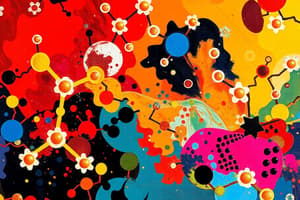Podcast
Questions and Answers
What characteristic defines deoxy sugars?
What characteristic defines deoxy sugars?
- A hydroxyl group is replaced by a methyl group.
- A hydroxyl group is replaced by a hydrogen atom. (correct)
- A hydroxyl group is replaced by a halogen atom.
- A hydrogen atom is added to the terminus of the sugar.
Which sugar acid is formed through the oxidation of the aldehyde group of an aldose?
Which sugar acid is formed through the oxidation of the aldehyde group of an aldose?
- Galactosamine
- L-Iduronic acid
- Gluconic acid (correct)
- D-Glucuronic acid
Which sugar derivative is characterized by the substitution of a hydroxyl group with an amino group?
Which sugar derivative is characterized by the substitution of a hydroxyl group with an amino group?
- Gluconic acid
- Deoxyribose
- Galactosamine (correct)
- Sorbitol
Which of the following statements about sugar alcohols is correct?
Which of the following statements about sugar alcohols is correct?
What is a common characteristic of uronic acids?
What is a common characteristic of uronic acids?
Which sugar derivative is a constituent of riboflavin (vitamin B2)?
Which sugar derivative is a constituent of riboflavin (vitamin B2)?
What functional group is replaced by amine in amino sugars?
What functional group is replaced by amine in amino sugars?
What is the primary function of sorbitol in metabolic processes?
What is the primary function of sorbitol in metabolic processes?
Flashcards
Deoxy Sugars
Deoxy Sugars
Sugars where a hydroxyl group on carbon 2 is replaced by a hydrogen atom.
Deoxyribose
Deoxyribose
A deoxy sugar, specifically the sugar found in DNA.
Amino Sugars
Amino Sugars
Sugars with an amino group replacing a hydroxyl group, usually on carbon 2.
Glucosamine
Glucosamine
Signup and view all the flashcards
Aldonic Acids
Aldonic Acids
Signup and view all the flashcards
Uronic Acids
Uronic Acids
Signup and view all the flashcards
Sugar Alcohols
Sugar Alcohols
Signup and view all the flashcards
Sorbitol
Sorbitol
Signup and view all the flashcards
Study Notes
Carbohydrates Chemistry - Sugar Derivatives
- Sugar derivatives are sugar molecules that have been modified with substituents other than hydroxyl groups.
- Deoxy sugars are sugars where a hydroxyl group attached to the C₂ of the sugar is replaced by a hydrogen atom.
- Example: Deoxyribose, a sugar present in DNA.
- Amino sugars have an amino group replacing the hydroxyl group on the second carbon.
- Example: Glucosamine, a constituent of hyaluronic acid and heparin; and Galactosamine, a constituent of chondroitin sulphate.
- Sugar acids are formed by oxidation of the aldehyde group (CHO) of aldoses to a carboxyl group (COOH).
- Aldonic acids result from this oxidation.
- Example: Gluconic acid from glucose.
- Uronic acids result from oxidizing the primary alcohol group (CH₂OH) of aldoses to a carboxyl group.
- Example: D-Glucuronic acid from glucose; L-Iduronic acid, part of chondroitin sulfate B.
- Aldonic acids result from this oxidation.
- Sugar alcohols result from the reduction of the carbonyl group to an alcohol group.
- Example: Sorbitol, the alcohol of glucose, and an intermediate in glucose-to-fructose conversion in seminal vesicles; Ribitol, the alcohol of ribose, part of riboflavin (vitamin B₂).
- Isomers are compounds that have the same molecular formula but different structures.
- D and L isomers are mirror images of each other.
- Enantiomers are optical isomers, a type of stereoisomer.
Studying That Suits You
Use AI to generate personalized quizzes and flashcards to suit your learning preferences.




